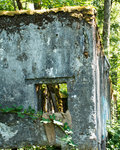


At first glance, the concrete shell of the structure doesn’t look like anything more than freestanding rubble.
Discarded clothes sit draped over exposed beams and window sills. Bags of trash litter the ground next to trees that have taken over a structure covered with enough moss that the stone blends in with the canopy of the wooded area near the Agnew Mill Ponds.
Odds are that none of the transient persons whose tents ring the exterior know that they’re camping on ground that was once at the center Centralia’s timber economy.
The structure in question used to be part of the Agnew Lumber Company site operated by Samuel Alexander Agnew, more commonly known as S.A. Agnew, during the 1940s and 1950s. Before that, it housed part of the Eastern Railway and Lumber Company, which reigned as one of the biggest commercial operations in Lewis County for nearly 40 years until 1939 when a fire gutted the operation.
Long forgotten to all but a few dedicated history buffs, the remaining structures are back in the public realm as part of the ongoing China Creek Restoration Project.
The building footprint sits within the proposed Phase II of the project designed to curtail flooding out of the creek during winter months. The Centralia City Council approved funds on Tuesday to pay for an archaeologist to research and document the structure in order to create a Historic Property Inventory Form as plans for Phase II continue to take shape.
Centralia Public Works Director Kim Ashmore doesn’t anticipate the city doing anything to disturb the property or that it would force changes to planned expansion of water storage within the Agnew Mill Ponds.
“There’s some historic value to it,” Ashmore said. “I’m not sure the structure would be safe for people to be walking through and we wouldn’t want a kid climbing on it, and it topples over and they get hurt. I don’t think it’ll be something we get a historic marker for, but it’s definitely a part of Centralia history.”
Members of the general public are advised not to seek out the structure, in part because the only true access point is located on Burlington Northern Santa Fe Railway Company property.
S.A. Agnew first became a baron of the Washington lumber economy in the late 1920s. He oversaw approximately 12,000 acres of logging land in Washington and employed nearly 400 people from 1941 until the mill closed in 1959.
Lewis County Historical Museum Director Jason Mattson dug out a 1962 map of the city that showed Agnew Lumber Company land butting up against the old Centralia city golf course on Seminary Hill.
Agnew passed away in June of 1965 at the age of 86 due to complications from a stroke. The day after his death, The Chronicle ran an editorial that lauded the “sawdust fund” he established to help retired and current employees in need.
“The moment is one of loss and sorrow for his family and for many friends, some of them his employees for almost a lifetime,” read the editorial attributed to publisher John B. Edinger. “For the community, the loss is a man who contributed immeasurably at times to the economy and growth of this area. We are not likely to know another like him.”
While the mill building itself is not likely to ever serve as a public remembrance to Agnew or the logging industry, another option may someday be feasible.
A concrete tunnel with an opening off East Fourth Street on the west side of the railroad tracks was used for decades by employees who would walk underneath the rail yard to and from work. It may have also been used to transport wood from the Agnew mill to a storage shed at the intersection of East Fourth Street and B Street that later became home to the Lewis County Lumber company.
The Fourth Street entrance is barely visible today. Only the very top of the subway-like staircase down to the tunnel is visible above 50 years worth of dirt and rocks that has filled the opening.
About 100 yards from the remnants of the Agnew Lumber Company building, the exit isn’t in much better shape, though the stairs are still passable down to a layer of trash and debris.
The condition of the tunnel itself isn’t known. Odds are even that it’s either completely caved in or entirely intact.
“It would be pretty cool if we could ever get the material out and people could see how workers in the early 1900s traveled to their jobs,” Ashmore said. “That tunnel has always fascinated me during my 34 years with the city.”
Until then, the last vestiges of one of the most prominent industrial operations to ever grace the Hub City will sit dormant without much chance of ever roaring back to life.